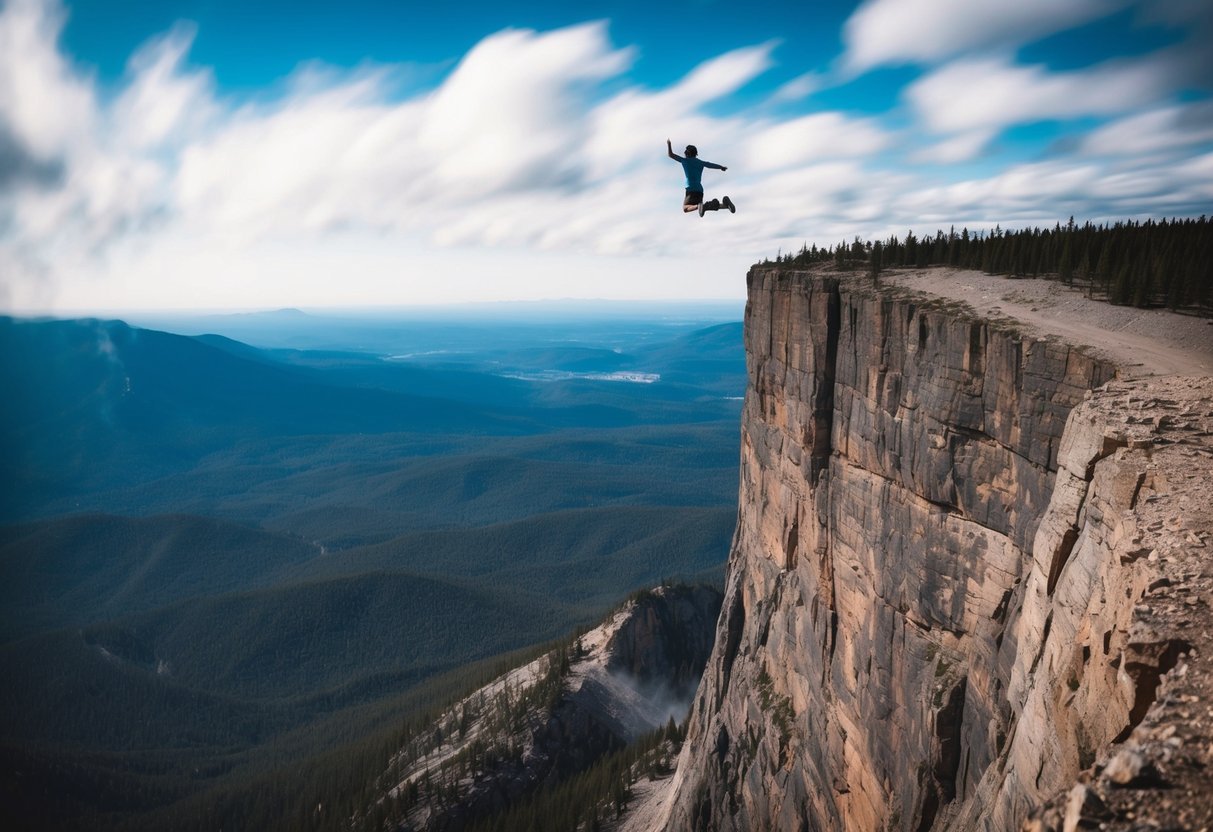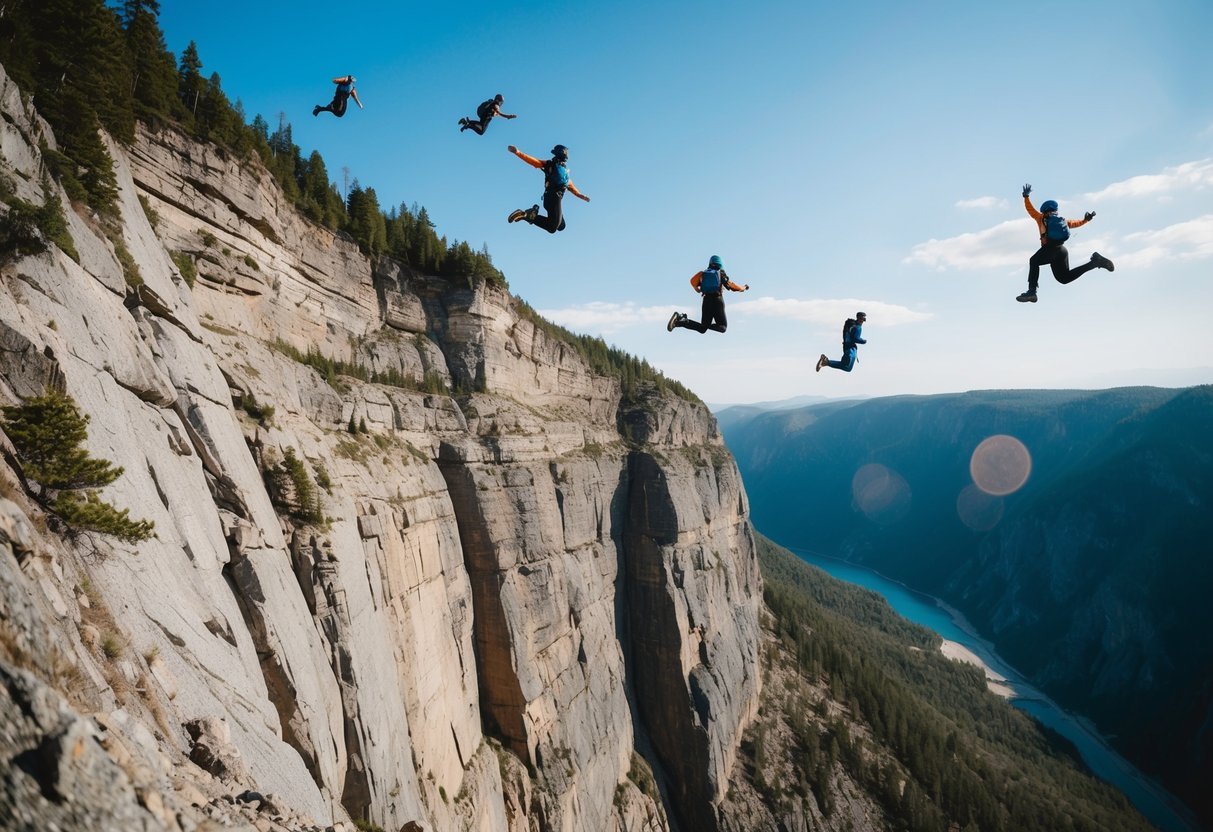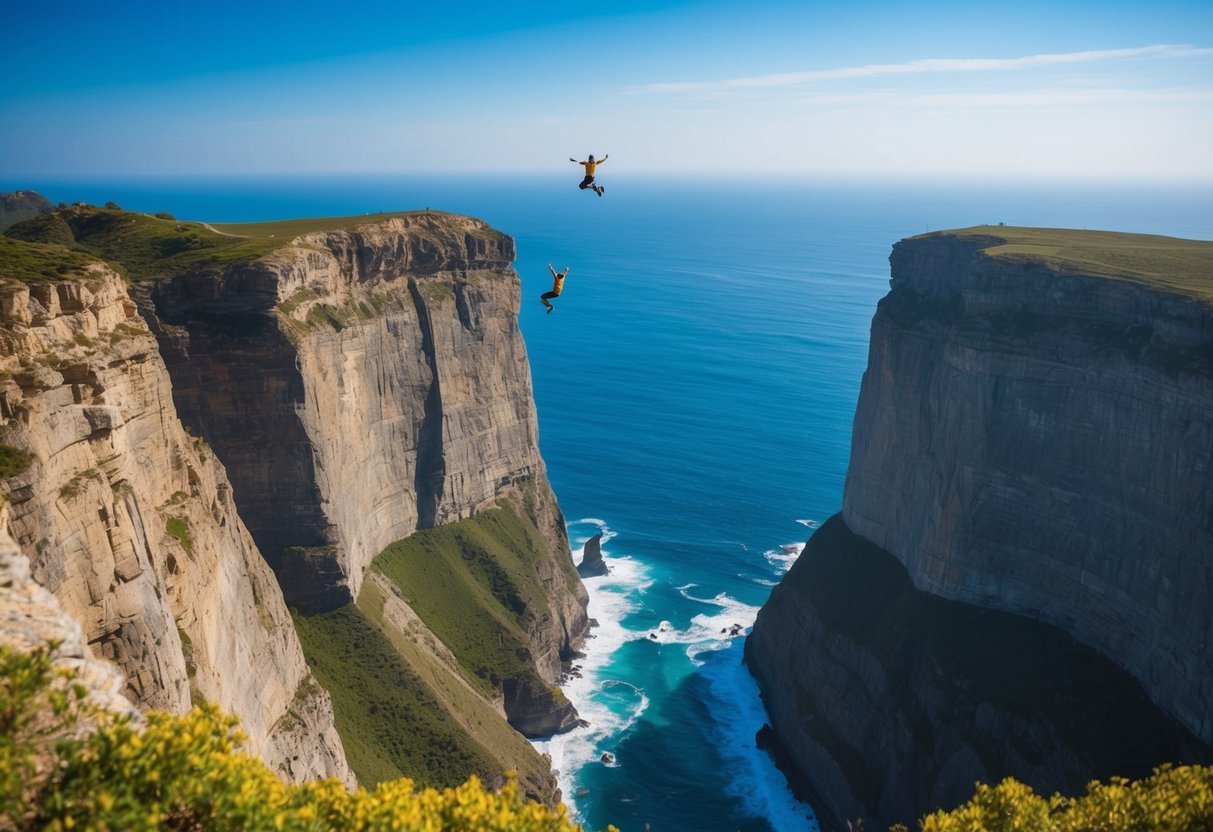Base jumping is an adrenaline-pumping extreme sport that pushes the boundaries of human courage and skill.
Leaping from towering cliffs with only a parachute between you and the ground, this heart-racing activity offers unparalleled thrills for daredevils seeking the ultimate rush.
For those brave enough to take the plunge, choosing the right location can make all the difference in your base jumping experience. From breathtaking natural formations to man-made structures, the world offers a variety of stunning spots for base jumpers to test their mettle.
In this article, we’ll explore five of the most exhilarating cliffs that promise unforgettable base jumping adventures.
1) Norway’s Kjerag Cliff
Ready for an adrenaline rush? Look no further than Kjerag cliff in Norway.
This jaw-dropping location is a favorite among base jumpers worldwide.
Kjerag towers over the stunning Lysefjord, offering a breathtaking 12-second free fall that’ll make your heart race.
It’s no wonder thrill-seekers flock here year after year.
Since the first jump in 1994, Kjerag has seen over 55,000 jumps.
The vertical drop from the mountainside gives you plenty of time to show off your skills with front flips and other tricks.
But remember, base jumping isn’t for the faint of heart.
It’s considered one of the world’s most dangerous pursuits.
Always prioritize safety and follow local guidelines.
Want to experience Kjerag without taking the plunge? The cliff offers spectacular views for hikers too.
You’ll be treated to breathtaking vistas of the fjord below.
2) Troll Wall in Norway
Ready for a jaw-dropping base jumping experience? Look no further than the Troll Wall in Norway, Europe’s tallest vertical rock face.
This massive cliff towers an impressive 1,100 meters above the Romsdalen Valley.
The Troll Wall’s jagged peaks are said to resemble petrified trolls, adding a touch of Nordic folklore to your adventure.
As you prepare for your jump, you’ll feel the rush of adrenaline coursing through your veins.
Since its first climb in 1965, the Troll Wall has become a mecca for thrill-seekers. Base jumping here offers an unparalleled experience, with breathtaking views of the surrounding landscape.
Remember, this isn’t a spot for beginners.
The Troll Wall demands respect and expertise.
Frequent rock falls make it a challenging and potentially dangerous location.
As you leap from the cliff, you’ll experience an incredible sense of freedom.
The sheer drop and stunning scenery make this one of the most exhilarating jumps you’ll ever attempt.
3) Half Dome in Yosemite, USA
You’ve probably seen pictures of this iconic granite dome, but have you ever thought about jumping off it? Half Dome in Yosemite National Park offers a thrilling base jumping experience for the brave.
Standing at 8,844 feet (2,695 meters) above sea level, Half Dome provides an epic backdrop for your jump.
The sheer vertical face drops about 4,800 feet to the valley floor, giving you plenty of time to enjoy the rush.
Before you can make the leap, you’ll need to tackle the challenging 14-16 mile hike to reach the summit.
It’s no walk in the park, but the views from the top are worth every step.
Once you’re up there, take a moment to soak in the breathtaking panorama of Yosemite Valley.
Then, when you’re ready, it’s time for the main event.
As you jump, you’ll feel the exhilaration of free-falling alongside this massive rock formation.
Remember, base jumping in Yosemite is illegal and extremely dangerous.
Only attempt this if you’re an experienced jumper and willing to face the consequences.
Always prioritize safety and respect for nature.
4) Preikestolen, Norway
Preikestolen, also known as Pulpit Rock, is a jaw-dropping cliff that’ll get your adrenaline pumping.
This natural wonder towers 604 meters above Lysefjorden, offering a breathtaking platform for base jumping enthusiasts.
The flat-top surface of Preikestolen spans about 25 by 25 meters, giving you ample space to prepare for your leap.
As you stand on the edge, you’ll be treated to stunning views of the fjord below.
Base jumping at Preikestolen combines the thrill of freefall with Norway’s spectacular scenery.
The sheer cliffs and dramatic landscape make it a must-try spot for adventure seekers.
Before you take the plunge, you’ll need to hike to reach Preikestolen.
The trail covers about 3.8 km each way, with a challenging but well-maintained path.
Remember, safety is crucial when base jumping from Preikestolen.
Make sure you have the right gear and proper training before attempting this extreme sport.
The unique geology and breathtaking surroundings make this spot an unforgettable experience for thrill-seekers.
5) Table Mountain, South Africa
Ready for an adrenaline rush with a view? Table Mountain in Cape Town might be your next stop.
This iconic flat-topped mountain offers some seriously epic base jumping opportunities.
You’ll start your adventure with a challenging hike to the summit.
The Platteklip Gorge route is popular, taking about 2-3 hours to reach the top.
But trust us, the climb is worth it for the jump ahead.
Once you’re at the top, take a moment to soak in the incredible panoramic views of Cape Town, the coastline, and beyond.
It’s a sight you won’t forget.
When you’re ready to take the plunge, you’ll be launching from a height of over 1,000 meters.
The vertical cliffs provide a perfect jumping spot for experienced base jumpers.
Remember, base jumping here isn’t exactly encouraged by the authorities.
You’ll need to be discreet and jump at your own risk.
Always prioritize safety and check the weather conditions before attempting any jump.
After your heart-pounding descent, why not celebrate with a ride down in the cable car? It’s a more relaxed way to end your Table Mountain adventure.
History of Base Jumping

Base jumping has evolved from daring stunts to a recognized extreme sport.
Its origins trace back to early parachuting pioneers, with modern BASE jumping emerging in the late 20th century.
Origins and Evolution
You might be surprised to learn that BASE jumping’s roots go back to the 1960s.
It all started with guys like Rod Pack and Brian Schubert, who decided to jump off El Capitan in Yosemite National Park.
Talk about gutsy!
But it wasn’t until the 1980s that BASE jumping really took off.
Carl Boenish, often called the father of modern BASE jumping, coined the term and helped popularize the sport.
He filmed jumps and pushed the boundaries of what was possible.
As equipment improved, so did the jumps.
Wingsuits entered the scene, letting jumpers soar like flying squirrels.
Pretty cool, right?
Impact of BASE on Extreme Sports
BASE jumping has seriously shaken up the extreme sports world.
It’s pushed the limits of what people thought was possible and inspired a whole new generation of thrill-seekers.
You’ve probably seen BASE jumpers in action movies or viral videos.
These heart-stopping stunts have captured the public’s imagination and brought extreme sports into the mainstream.
But it’s not just about the rush.
BASE jumping has spurred innovations in safety equipment and techniques that benefit other sports too.
Skydivers, paragliders, and even rock climbers have all borrowed ideas from BASE.
The sport has also sparked debates about risk-taking and personal freedom.
It’s made us question how far we’re willing to go for a thrill.
Safety Considerations

Base jumping demands meticulous preparation and respect for the risks involved.
Proper gear and thorough risk assessment are crucial to maximize safety while pursuing this extreme sport.
Essential Gear
Your life depends on having the right equipment.
A well-maintained parachute system is non-negotiable.
You’ll need a main canopy and a reserve chute, both specifically designed for BASE jumping.
A sturdy helmet protects your head from impacts.
Choose one that doesn’t obstruct your vision.
Proper attire is key.
Wear clothing that won’t snag or interfere with your gear.
Opt for sturdy, ankle-supporting shoes with good grip.
Don’t forget a reliable altimeter to track your altitude.
Some jumpers use audible altimeters for added safety.
Lastly, invest in a quality jumpsuit.
It should be aerodynamic and allow for easy access to your gear.
Risk Assessment and Management
Before you leap, thoroughly assess the jump site.
Check wind conditions, as they can drastically affect your jump.
Strong winds are a no-go.
Study the landing area carefully.
Look for potential hazards like rocks, trees, or power lines.
Always have a backup landing zone in mind.
Know your limits.
Don’t attempt jumps beyond your skill level.
It’s crucial to progress gradually, mastering each level before moving to more challenging jumps.
Competitions and organized events can offer safer jumping experiences.
They often provide controlled environments with emergency services on standby.
Consider jumping with a partner.
They can spot you and provide assistance if needed.
Remember, there’s safety in numbers when it comes to extreme sports.
Environmental and Legal Aspects

Base jumping’s thrill comes with important environmental and legal considerations.
You’ll need to navigate regulations and understand your impact on nature to enjoy this extreme sport responsibly.
Legal Access and Permits
Getting legal access to jump sites can be tricky.
Many popular spots have strict regulations or outright bans.
You might face trespassing charges for unauthorized jumps.
Some locations require permits, while others prohibit base jumping entirely.
Check local laws before planning your jump.
The Perrine Bridge in Twin Falls, Idaho is a rare exception, allowing year-round jumps without permits.
But this is uncommon.
Be prepared for potential legal consequences.
Breaking and entering, reckless endangerment, and vandalism charges aren’t unheard of for jumpers and their ground crews.
Conservation and Environmental Impact
Your jumps can affect local ecosystems.
Wildlife disturbance is a major concern, especially in cliff areas where birds nest.
Stick to designated paths to avoid damaging vegetation.
Repeated jumps from the same spot can lead to erosion and habitat destruction.
Consider the impact of your gear.
Accidentally dropped equipment can harm animals or litter pristine environments.
Always pack out what you bring in.
Some areas restrict base jumping during certain seasons to protect breeding wildlife.
Respect these closures to help preserve natural habitats for future jumpers to enjoy.
Frequently Asked Questions
BASE jumping attracts thrill-seekers worldwide with its adrenaline-pumping leaps.
Let’s dive into some common questions about this extreme sport, covering top locations, costs, safety considerations, and legal aspects.
What are the top spots for BASE jumping in the United States?
The United States offers several iconic BASE jumping locations. Half Dome in Yosemite is a legendary spot for experienced jumpers.
Other popular sites include the New River Gorge Bridge in West Virginia and the Perrine Bridge in Idaho.
How much does it typically cost to go BASE jumping?
BASE jumping can be a pricey pursuit. A European BASE expedition might set you back up to $4,350.
You’ll also need to factor in the cost of skydiving lessons and equipment.
A BASE pilot chute alone can cost around $146.
Can you give me the rundown on BASE jumping at Perrine Bridge?
Perrine Bridge in Twin Falls, Idaho, is a year-round BASE jumping hotspot.
It’s one of the few places in the US where BASE jumping is legal without a permit.
The bridge stands 486 feet above the Snake River, offering jumpers a thrilling 4-second freefall.
What’s the lowdown on BASE jumping death rates?
BASE jumping is considered one of the most dangerous extreme sports.
While exact statistics vary, the fatality rate is significantly higher than skydiving.
It’s crucial to undergo proper training and always prioritize safety.
Where can you legally BASE jump in California?
California has limited legal BASE jumping options.
El Capitan in Yosemite National Park allows jumps during certain times of the year with proper permits.
However, most BASE jumping in California occurs illegally or during sanctioned events.
How high does a BASE jump need to be to be considered safe?
The minimum safe height for BASE jumping depends on various factors.
Generally, experienced jumpers consider 250-300 feet as the minimum for a safe jump.
However, higher altitudes provide more time for canopy deployment and potential corrections.


